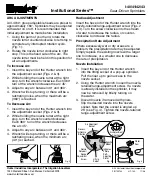
©
National Instruments Corp.
13
NI 9237E Operating Instructions and Specifications
sensors because there may be significant resistance in the wiring to
the active resistor in the bridge.
The NI 9237E shunt calibration circuitry consists of a precision
resistor and a software-controlled switch. Refer to the software
help for information about enabling the shunt calibration switch for
the NI 9237E. Visit
ni.com/info
and enter
cseriesdoc
for
information about C Series documentation.
Shunt calibration involves simulating the input of strain by
changing the resistance of an arm in the bridge by some known
amount. This is accomplished by shunting, or connecting, a large
resistor of known value across one arm of the bridge, creating a
known strain-induced change in resistance. You can then measure
the output of the bridge and compare it to the expected voltage
value. You can use the results to correct gain errors in the entire
measurement path, or to simply verify general operation to gain
confidence in the setup.
Use a stable signal, which is typically the unloaded state of the
sensor, first with the shunt calibration switch off and then again
with the switch on. The difference in these two measurements
provides an indication of the gain errors from wiring resistances.
You can design the software application to correct subsequent
readings for this gain error.














































